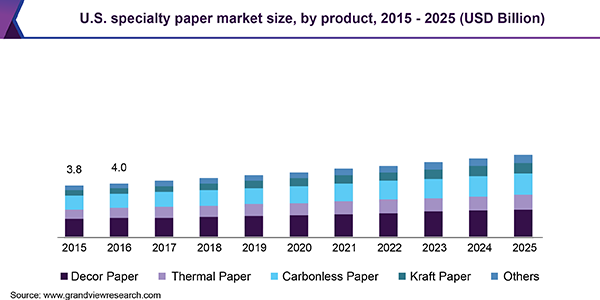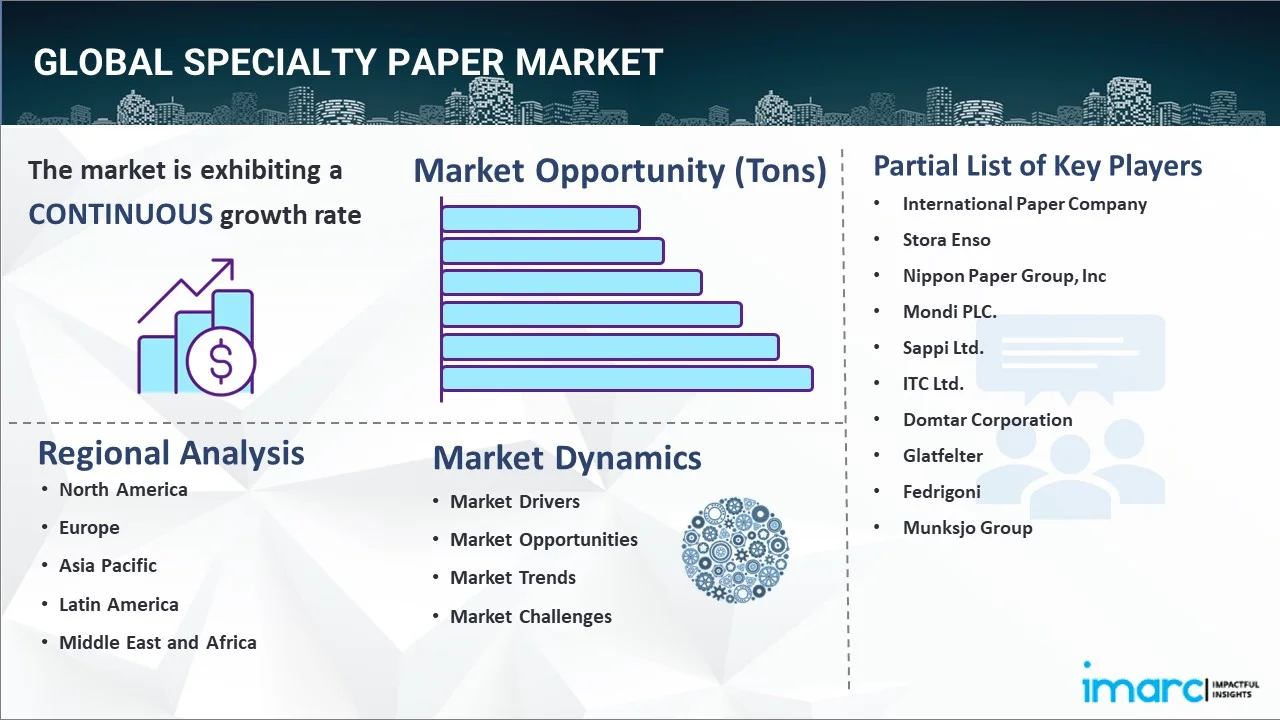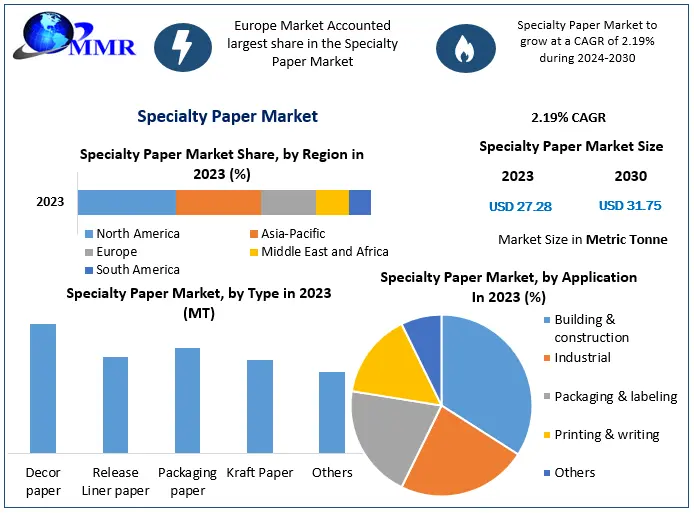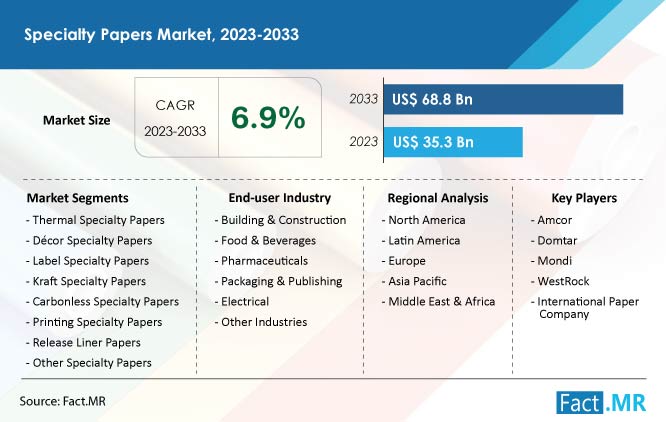Is the Specialty Paper Industry Evolving?
The Specialty Paper Industry Landscape
The specialty paper industry is a dynamic and rapidly growing sector that caters to various specialized applications. This industry encompasses a wide range of paper products that are designed for specific uses beyond printing or writing. Specialty papers are used in industries such as packaging, labeling, food service, medical, and many others.
Current Market Size of the Specialty Paper Industry
The global specialty paper market has been experiencing steady growth over the years. According to market research, the global specialty papers market is expected to reach 25.03 million tonnes in 2019, with a projected growth rate of 2.3% CAGR, reaching 28.02 million tonnes by 2024. This growth is driven by the increasing demand for specialty papers in various industries.
The Asia-Pacific region, particularly China and India, shows the strongest growth in specialty paper sales, with a projected annual growth rate of 3.8%. This growth is fueled by factors such as economic development, urbanization, and increasing e-commerce activities.
Major Players in the Specialty Paper Industry
The specialty paper industry is highly competitive and fragmented, with various companies vying for market share. Some of the major players in the specialty paper industry include KapStone, International Paper, Domtar, Sappi, Stora Enso, and Mondi Group, among others. These companies have established themselves as industry leaders through innovation, research and development, and strategic collaborations.
Evolution of the Specialty Paper Industry
The specialty paper industry has evolved significantly over the years, driven by changing customer needs, technological advancements, and environmental concerns. One notable trend is the conversion of commodity paper mills to produce specialty papers, as it offers economic advantages in terms of wider and faster machines.
Another significant development is the increasing demand for sustainable specialty papers. As consumers become more conscious about the environmental impact of packaging materials, there is a growing need for biodegradable and eco-friendly specialty papers. This has led to the development of water-based barrier coatings to replace fluorocarbons for food contact applications, as well as the ongoing research and development of eco-friendly alternatives.
The specialty paper industry has also witnessed increased demand for thermal and inkjet papers. With the rise of e-commerce and online shopping, there is a need for BPA-free thermal coatings for receipts and shipping labels. Additionally, specialty papers have found applications in the medical industry, such as sterilizable packaging, which is expected to grow at a rate of around 4.5% from 2019 to 2024.
In conclusion, the specialty paper industry is a thriving sector that offers unique paper products for various specialized applications. With the evolving market landscape and growing demand for sustainable solutions, the industry is poised for continued growth and innovation. The major players in this industry are continuously investing in research and development to meet the changing needs of consumers and to stay ahead of the competition. As new technologies and trends emerge, the specialty paper industry will continue to adapt and evolve, catering to the diverse needs of different industries worldwide.
Types of Specialty Papers
Specialty papers play a crucial role in various industries, providing unique characteristics and functionalities that go beyond those of regular printing or writing paper. These papers are specifically developed to cater to specific needs and applications, such as packaging, labeling, and decorative purposes. In this section, we will explore the most popular types of specialty papers in the market, the technological advancements shaping the specialty paper industry, and the initiatives taken to promote sustainability in the sector.
Popular Types of Specialty Papers
The specialty paper industry offers a wide range of products to meet the diverse needs of different industries. Some of the most popular types of specialty papers in the market include:
- Packaging Papers: Packaging papers are designed to provide enhanced protection and visual appeal to products. They offer superior strength, durability, and moisture resistance to ensure the safe transportation and storage of goods.
- Label Papers: Label papers are used for labeling and identification purposes. They come in various forms, such as pressure-sensitive labels, removable labels, and specialty adhesive labels. Label papers are often coated to improve printability and enhance the visual impact of labels.
- Decorative Papers: Decorative papers are known for their unique textures, patterns, and finishes. They are used in the production of high-quality books, stationery, gift wrapping, and luxury packaging. Decorative papers add an element of elegance and visual appeal to the end products.
- Electrical Papers: Electrical papers are specially designed to withstand high temperatures and provide excellent electrical insulation. They are commonly used in transformers, capacitors, electrical motors, and other electrical devices.
- Thermal Papers: Thermal papers are widely used in the retail and hospitality industries for printing receipts, tickets, and labels. They have a heat-sensitive coating that reacts to heat to produce images, eliminating the need for ink cartridges or toners.
- Release Papers: Release papers have a special coating that allows them to release from adhesive surfaces without causing damage or leaving residue. They are commonly used in the production of labels, tapes, and graphic arts applications.
Technological Advancements in the Specialty Paper Industry
Technological advancements have significantly influenced the specialty paper industry, leading to the development of innovative products and manufacturing processes. These advancements have improved the performance and functionalities of specialty papers, making them more versatile and adaptable to changing market demands. Here are some key technological advancements shaping the specialty paper industry:
- Advanced Coating Techniques: Coating is a critical process in specialty paper manufacturing that enhances the characteristics and functionalities of the paper. Advanced coating techniques, such as nano-coating and micro-patterning, have enabled the production of papers with superior barrier properties, printability, and smoothness.
- Sustainable Production Methods: The specialty paper industry is adopting sustainable production methods to reduce its environmental impact. Advanced technologies, such as water-based coatings and solvent-free adhesives, are being used to minimize the use of hazardous chemicals and reduce emissions.
- Digital Printing Technologies: Digital printing technologies have revolutionized the specialty paper industry by enabling the production of personalized and on-demand printing. These technologies offer high-quality printing with shorter turnaround times and lower costs, leading to increased customization and flexibility in the specialty paper market.
- Fiber Modification Techniques: Fiber modification techniques, such as nanotechnology, have been used to enhance the strength, durability, and absorption properties of specialty papers. These techniques allow manufacturers to tailor the paper’s characteristics to specific applications, such as packaging, filtration, and medical disposables.
Initiatives to Promote Sustainability in the Specialty Paper Sector
The specialty paper industry is committed to promoting sustainability and addressing environmental concerns. Here are some initiatives being taken to promote sustainability in the specialty paper sector:
- Use of Sustainable Raw Materials: Specialty paper manufacturers are increasingly using sustainably sourced raw materials, such as certified wood fibers and recycled paper, to reduce deforestation and minimize waste generation.
- Implementation of Energy-Efficient Practices: Energy-efficient practices, such as the use of renewable energy sources, advanced process control systems, and optimized manufacturing processes, are being implemented to reduce greenhouse gas emissions and minimize energy consumption.
- Recycling and Waste Management: Specialty paper manufacturers are actively involved in recycling programs to ensure the efficient utilization of resources and minimize waste generation. They are also exploring innovative methods, such as closed-loop systems and waste-to-energy technologies, to further reduce their environmental footprint.
- Development of Biodegradable Specialty Papers: Special efforts are being made to develop biodegradable specialty papers to address growing environmental concerns. These papers are designed to decompose naturally, minimizing their impact on ecosystems and reducing landfill waste.
In conclusion, the specialty paper industry offers a wide range of products to meet the demands of various industries. Technological advancements have played a significant role in shaping the industry, leading to the development of innovative products and manufacturing processes. Moreover, sustainability is a key focus area for the specialty paper sector, and initiatives are being taken to promote environmentally friendly practices and materials. With continuous advancements and a commitment to sustainability, the specialty paper industry is well-positioned to meet the evolving needs of the market.
Future Outlook and Trends
The specialty paper industry is showing promising growth opportunities and emerging trends that are shaping its future. In this section, we will explore the growth opportunities, emerging trends, and future outlook of the specialty paper market.
Growth Opportunities in the Specialty Paper Industry
The specialty paper industry is projected to witness substantial growth in the coming years. According to industry reports, the global specialty papers market is expected to reach 28.02 million tonnes by 2024 with a compound annual growth rate (CAGR) of 2.3%. The Asia-Pacific region, particularly China and India, is expected to show the strongest growth in specialty paper sales with a projected annual growth rate of 3.8%.
One of the key growth opportunities in the specialty paper industry lies in the conversion of commodity paper mills to produce specialty papers. This trend is driven by the economic advantages of wider and faster machines, enabling these mills to meet the growing demand for specialty papers.
Flexible packaging remains the largest sector within the specialty paper industry, and it is experiencing significant growth supported by environmental regulations and the shift from plastic to paper packaging. With the increasing demand for sustainable packaging solutions, there is a growing need for specialty papers that provide barrier coatings to replace fluorocarbons. Research and development efforts are focused on developing eco-friendly alternatives such as water-based barrier coatings for food contact applications.
The demand for thermal and inkjet papers is also on the rise due to the growth of e-commerce and online shopping. BPA-free thermal coatings are being developed to cater to the increasing demand for secure and eco-friendly packaging solutions. Moreover, the medical applications of specialty papers, such as sterilizable packaging, are expected to grow at a rate of around 4.5% from 2019 to 2024.
Emerging Trends in the Specialty Paper Industry
Several emerging trends are reshaping the specialty paper industry and driving its growth. One such trend is the need for secure packaging solutions with features like holograms, UV-reactive inks, and microprinting. These features help in anti-counterfeiting efforts, particularly in industries such as pharmaceuticals and luxury goods.
Another emerging trend in the specialty paper industry is the rise in premium offerings that utilize unique textures and finishes of specialty papers. This trend caters to the increasing demand for visually appealing and high-quality packaging solutions in various industries.
In response to growing environmental concerns, there is a significant shift towards the development of biodegradable specialty papers. These eco-friendly papers offer sustainable alternatives to conventional papers, contributing to the overall sustainability of the packaging industry.
Future Outlook of the Specialty Paper Market
The future outlook of the specialty paper market is optimistic, driven by factors such as the increasing demand for sustainable and eco-friendly packaging solutions. According to market research reports, the specialty paper market size is projected to reach $28.1 billion by 2030, growing at a CAGR of 7.2% from 2023 to 2030.
The Asia-Pacific region is expected to lead the specialty paper market due to the rapid growth of consumerism and the increasing demand for specialized packaging solutions in countries like China and India. Packaging and labeling applications are expected to dominate the market, driven by consumer preferences for unique packaging and labeling designs.
To capitalize on the growth opportunities, key players in the specialty paper industry are focusing on innovation, eco-friendly practices, and collaborations. By leveraging technological advancements and sustainable practices, these players aim to expand their market presence and meet the evolving needs of customers.
In summary, the specialty paper industry is poised for growth. With various growth opportunities, emerging trends, and a positive future outlook, the specialty paper market is set to witness significant developments in terms of demand and innovations. As the market continues to expand, industry players and stakeholders must stay proactive and adapt to the changing dynamics in order to thrive in this competitive landscape.
FAQs about the Specialty Paper Industry Landscape
How to calculate Precision in the specialty paper industry context?
To calculate Precision in the specialty paper industry context, use the formula Precision = tp / (tp + fp), where tp represents the number of correct tokens shared between the prediction and the answer, and fp is the number of tokens present in the prediction but not in the correct answer.
How to determine Recall in the specialty paper industry landscape?
To determine Recall in the specialty paper industry landscape, apply the equation Recall = tp / (tp + fn), where tp denotes the tokens shared between the correct answer and the prediction, and fn represents the number of tokens existing in the correct answer but not in the prediction.
What are some key facts about the current market size of the specialty paper industry?
The global specialty paper market is anticipated to reach 25.03 million tonnes in 2019, with an estimated growth rate of 2.3% CAGR, reaching 28.02 million tonnes by 2024 due to the increasing demand for specialty papers in various industries, particularly in the Asia-Pacific region.
How do major players in the specialty paper industry establish themselves as industry leaders?
Major players in the specialty paper industry, such as KapStone, International Paper, Domtar, and others, become industry leaders through innovation, research and development efforts, and strategic collaborations, showcasing their competitiveness in this dynamic and fragmented sector.
How has the specialty paper industry evolved over the years?
The
In conclusion, the specialty paper industry is thriving with a growing market size. Major players continue to innovate, driving technological advancements and sustainability efforts. Popular types of specialty papers shape the market trend, with a focus on eco-friendly solutions. Looking ahead, the industry holds promising growth opportunities and exciting emerging trends. The future looks bright, with increasing demand and ongoing innovations in specialty paper products.





